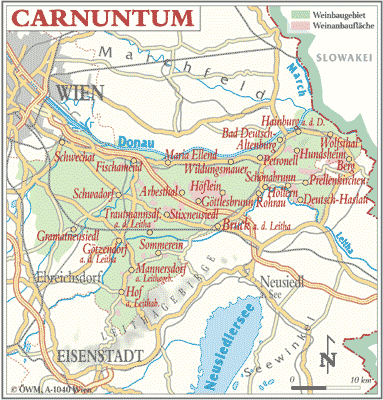
Wine-growing areas of Austria
Carnuntum
The Carnuntum region of Austria has a long tradition of viticulture stretching back to Celtic times. At the beginning of the first millennium the area became particularly important under the Romans.
The wine-growing area of Carnuntum covers an area southeast of Vienna and south of the Danube and is dominated by viticulture. The combination of the stony lime and loess soils of the Leithagebirge, the Arbesthaler Hügelland, and the Hainburger Bergen, the Pannonian climate with its hot summers and cold winters, the proximity of the Danube, and the temperature-regulating Lake Neusiedl (the Neusiedlersee), offers ideal natural conditions and spurs the red grapes to mature fully.
Carnuntum village represented a strategically ideal base for the Roman legions in their fight against the wild Germanians. Emperor Vespasian built fortified stone walls around the village and a harbour for the Danube fleet. Carnuntum soon became the military headquarters of the Pannonian province, the seat of the governor and also the occasional residence of Roman Caesars.
The name Carnuntum is of Illyrian origin and means “stone, cliff or firm place.”
Today, the Carnuntum is rich in Roman remains, including an amphitheatre, a Roman palace and, most famously, the 'Heidentor'. This originally four-pillar building, which was over 20 meters high, is supposed to have been erected under Emperor Constantin II (337-361) as a victory monument. The two remaining massive pillars, connected by an archway, have become the characteristic symbol of the Petronell-Carnuntum area.
